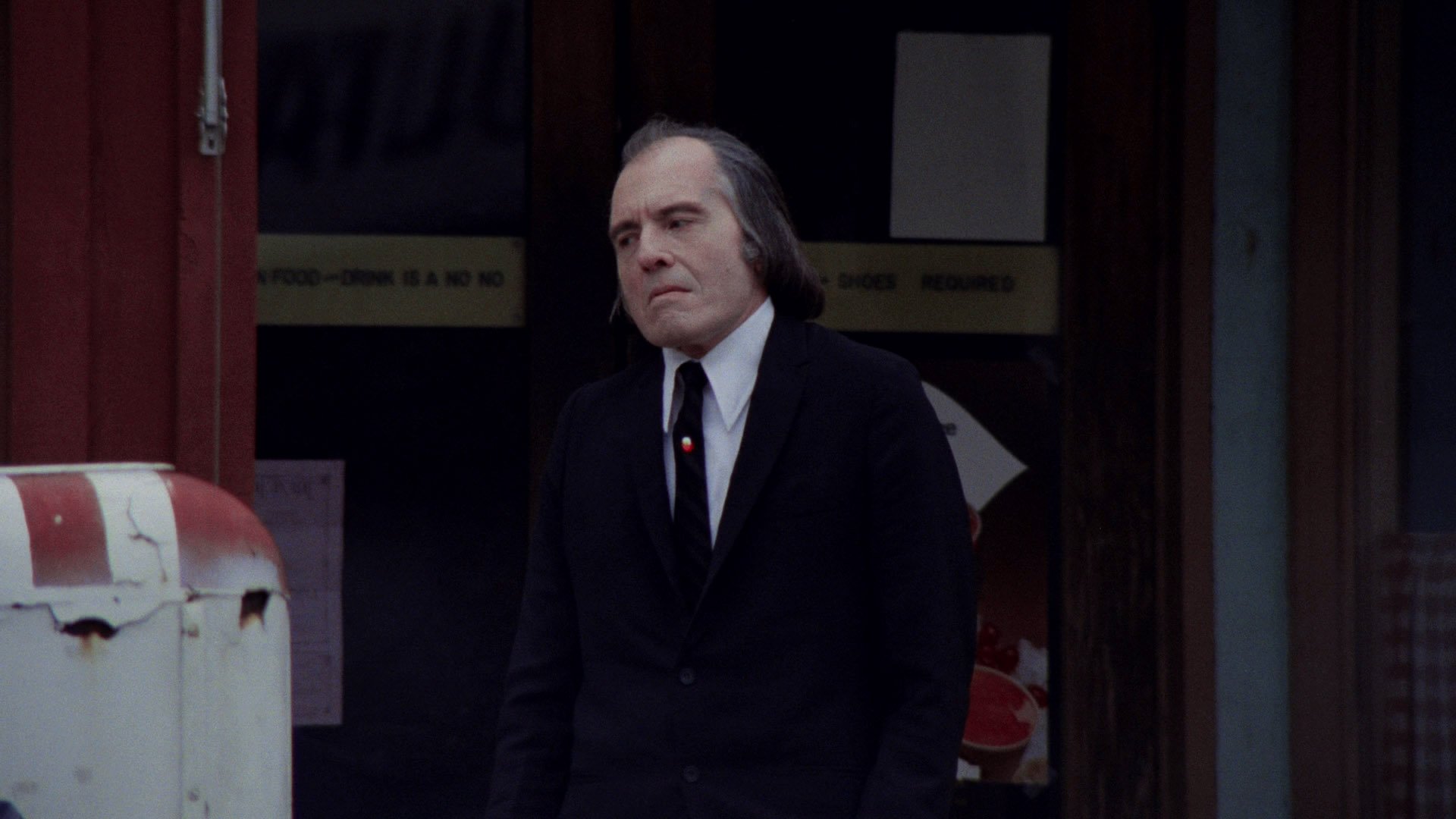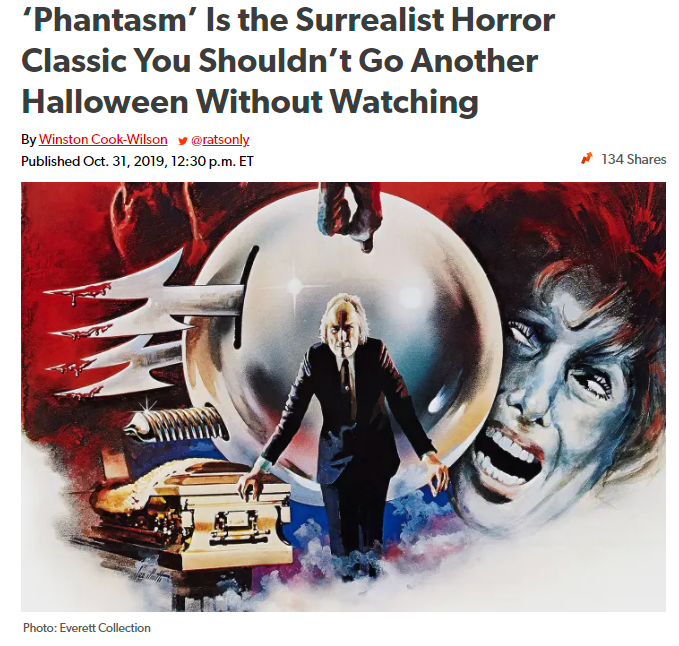Why PHANTASM is a Surrealist Horror Classic According to Decider.com
We absolutely loved this article from Decider.com titled: ‘Phantasm’ Is the Surrealist Horror Classic You Shouldn’t Go Another Halloween Without Watching!’ written by Winston Cook-Wilson.
As described in the first paragraph:
In the waning years of the 1970s, the tropes of horror film as we know it today were being invented or solidified with each new release. These were the years of Halloween and Alien, of Dawn of the Dead and Invasion of the Body Snatchers—some of the unimpeachable classics of slasher, zombie, and monster horror. Don Coscarelli’s 1979 debut film Phantasm should be ranked among their number as one of the most visionary horror films of its decade, but it is harder to characterize its legacy. Outside of the fact that it was more or less out of print for years, its profile has remained lower than those films because it was almost too weird to be imitated or have a clear impact on the genre. In some ways, the film borrows from all of the horror genres of its time, as well as sci-fi and fantasy, creating a heady, scrambled mix that still seems unique, and hard to put a name to.
Horror cinema is a genre renowned for its ability to invoke fear and unease in audiences through the use of dark, supernatural, and suspenseful elements. While many horror films adhere to conventional storytelling and scare tactics, some transcend the boundaries of traditional horror to create surreal and thought-provoking experiences. PHANTASM is one of these. "Phantasm" is a surrealist horror classic that defies easy categorization, offering viewers a nightmarish journey through a landscape of bizarre imagery, dreamlike sequences, and existential dread.
But does PHANTASM have influences? The Decider article asks this question…
It’s hard to think of this movie having influences, exactly; it seems too much like its own harebrained thing. But there are vestiges of great horror of the past: the careful use of shadow and close framing channels ’40s producer Val Lewton (the visionary behind Cat People) and Italian giallo‘s gory, heavily stylized terror. There is even more that feels ahead of its time: notably, The Tall Man’s mausoleum recalls Twin Peaks‘ Black Lodge over a decade before its creation; complete with creepy busts in front of red curtains, it is accessed through dreams as well as “reality.” Mike also catches a glimpse of another dimension that make Stranger Things and the Upside-Down seem like a lot less to write home about.
Incorporating surreal elements into horror cinema allowed filmmakers to delve into the hidden fears and desires of the human psyche. "Phantasm" is one of the prime examples of how these principles were effectively employed in the genre. "Phantasm" introduces viewers to a surreal and disorienting narrative from its very beginning. The story revolves around Mike, a teenage boy, who becomes suspicious of the local mortician known as the Tall Man. As Mike investigates further, he uncovers a nightmarish reality involving otherworldly creatures, killer spheres, and a gateway to another dimension. The plot is fraught with bizarre twists and turns that blur the line between dream and reality, leaving audiences unsure of what to believe.
The film's narrative structure mirrors the fragmented and unpredictable nature of dreams. Events occur seemingly at random, and the boundaries between the conscious and subconscious are blurred. Surrealism often seeks to disrupt conventional storytelling, and "Phantasm" achieves this by keeping the audience in a constant state of uncertainty, much like a fevered dream.
Surrealism thrives on symbolism and metaphor, and "Phantasm" is rich with both. The Tall Man, portrayed by the enigmatic Angus Scrimm, embodies the uncanny and sinister. He serves as a symbol of death, mortality, and the unknown. His ability to transform into different guises and manipulate reality reinforces the film's dreamlike quality. The film's central concept, the silver sphere, becomes a symbol of impending doom and inevitable mortality. It is a surreal and haunting image, rolling ominously towards its victims, and its grotesque penetration becomes a potent metaphor for the inevitability of death itself.
Surrealism relies heavily on the visual and atmospheric aspects of storytelling, and "Phantasm" excels in creating an eerie and dreamlike atmosphere. Cinematographer Don Coscarelli Jr.'s work in the film is notable for its use of wide-angle lenses, unconventional camera angles, and inventive framing. These techniques contribute to the film's disorienting and otherworldly feel.
The film's iconic soundtrack by Fred Myrow and Malcolm Seagrave is equally instrumental in shaping its surreal atmosphere. The hauntingly beautiful and discordant score adds an auditory layer to the dreamlike experience, enhancing the sense of unease and dislocation.
The Decider.com article wraps up by saying:
At that time of PHANTASM REMASTERED, Coscarelli still seemed surprised people were interested in Phantasm 40 years after its filming. “The fact that it has any longevity whatsoever is still really stunning to me,” he told BirthMoviesDeath. “But I will tell you the main theme is eternal. It’s about the fear of death and what happens after you die. Human beings are not going to answer those questions in our lifetime.” Whether or not that is exactly what every viewers get from Phantasm—pure zany fun works, too— it’s clear that there’s something buried in the movie that makes one want to return to this it again and again, just to try to uncover a bit more
So PHANTASM phans we have to ask. Which surreal elements of the original film are your favorites? Let us know on our official Instagram page!



